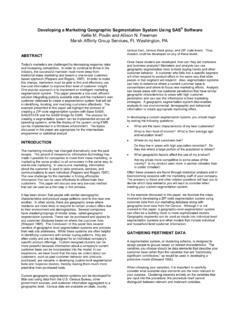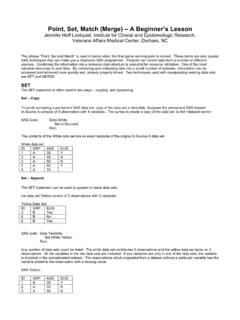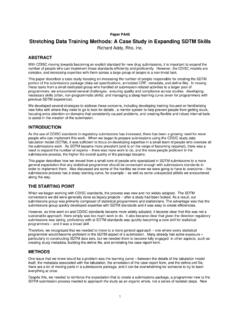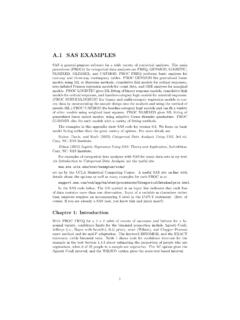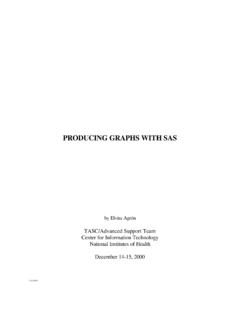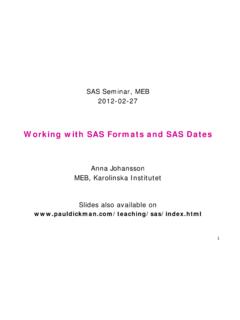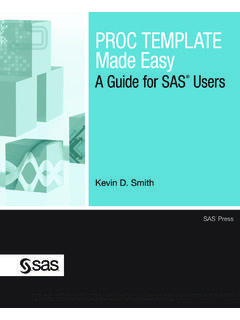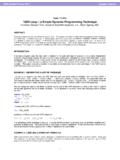Transcription of An Introduction to SAS® Hash Programming …
1 1 An Introduction to SAS hash Programming Techniques Kirk Paul Lafler, Software Intelligence Corporation, Spring Valley, California Abstract SAS users are always interested in learning techniques that will help them improve the performance of table lookup, search, and sort operations. SAS software supports a DATA step Programming technique known as a hash object to associate a key with one or more values. This presentation introduces what a hash object is, how it works, the syntax required, and simple applications of it use. Essential Programming techniques will be illustrated to sort data and search memory-resident data using a simple key to find a single value. Introduction One of the more exciting and relevant Programming techniques available to SAS users today is the hash object. Available as a DATA step construct, users are able to construct relatively simple code to perform match-merge and/or join operations.
2 The purpose of this paper and presentation is to introduce the basics of what a hash table is and to illustrate practical applications so SAS users everywhere can begin to take advantage of this powerful Base-SAS Programming feature. example Tables The data used in all the examples in this paper consists of a Movies table containing six columns: title, length, category, year, studio, and rating. Title, category, studio, and rating are defined as character columns with length and year being defined as numeric columns. The data stored in the Movies table is shown below. MOVIES Table The second table used in the examples is the ACTORS table. It contains three columns: title, actor_leading, and actor_supporting, all of which are defined as character columns, and is illustrated below. ACTORS Table 2 What is a hash Object?
3 A hash object is a data structure that contains an array of items that are used to map identifying values, known as keys ( , employee IDs), to their associated values ( , employee names or employee addresses). As implemented, it is designed as a DATA step construct and is not available to any SAS PROC edures. The behavior of a hash object is similar to that of a SAS array in that the columns comprising it can be saved to a SAS table, but at the end of the DATA step the hash object and all its contents disappear. How Does a hash Object Work? A hash object permits table lookup operations to be performed considerably faster than other available methods found in the SAS system. Unlike a DATA step merge or PROC SQL join where the SAS system repeatedly accesses the contents of a table stored on disk to perform table lookup operations, a hash object reads the contents of a table into memory once allowing the SAS system to repeatedly access it, as necessary.
4 Since memory-based operations are typically faster than their disk-based counterparts, users generally experience faster and more efficient table lookup operations. The following diagram illustrates the process of performing a table lookup using the Movie Title ( , key) in the MOVIES table matched against the Movie Title ( , key) in the ACTORS table to return the ACTOR_LEADING and ACTOR_SUPPORTING information. Figure 1. Table Lookup Operation with Simple Key Although one or more hash tables may be constructed in a single DATA step that reads data into memory, users may experience insufficient memory conditions preventing larger tables from being successfully processed. To alleviate this kind of issue, users may want to load the smaller tables as hash tables and continue to sequentially process larger tables containing lookup keys.
5 hash Object Syntax Users with DATA step Programming experience will find the hash object syntax relatively straight forward to learn and use. Available in all operating systems running SAS 9 or greater, the hash object is called using methods. The syntax for calling a method involves specifying the name of the user-assigned hash table, a dot (.), the desired method ( , operation) by name, and finally the specification for the method enclosed in parentheses. The following example illustrates the basic syntax for calling a method to define a key. ( Title ); where: HashTitles is the name of the hash table, DefineKey is the name of the called method, and Title is the specification being passed to the method. hash Object Methods Under SAS 9, the author identifies twenty six (26) known methods. The following table illustrates an alphabetical list of the available methods.
6 MOVIES Table ACTORS Table TITLE TITLE ACTOR_LEADING ACTOR_SUPPORTING Brave Heart Brave Heart Mel Gibson Sophie Marceau .. Christmas Vacation Chevy Chase Beverly D Angelo Christmas Vacation Coming to America Eddie Murphy Arsenio Hall Coming to America .. 3 Method Description ADD Adds data associated with key to hash object. CHECK Checks whether key is stored in hash object. CLEAR Removes all items from a hash object without deleting hash object. DEFINEDATA Defines data to be stored in hash object. DEFINEDONE Specifies that all key and data definitions are complete. DEFINEKEY Defines key variables to the hash object. DELETE Deletes the hash or hash iterator object. EQUALS Determines whether two hash objects are equal. FIND Determines whether the key is stored in the hash object. FIND_NEXT The current list item in the key s multiple item list is set to the next item.
7 FIND_PREV The current list item in the key s multiple item list is set to the previous item. FIRST Returns the first value in the hash object. HAS_NEXT Determines whether another item is available in the current key s list. HAS_PREV Determines whether a previous item is available in the current key s list. LAST Returns the last value in the hash object. NEXT Returns the next value in the hash object. OUTPUT Creates one or more data sets containing the data in the hash object. PREV Returns the previous value in the hash object. REF Combines the FIND and ADD methods into a single method call. REMOVE Removes the data associated with a key from the hash object. REMOVEDUP Removes the data associated with a key s current data item from the hash object. REPLACE Replaces the data associated with a key with new data. REPLACEDUP Replaces data associated with a key s current data item with new data.
8 SETCUR Specifies a starting key item for iteration. SUM Retrieves a summary value for a given key from the hash table and stores the value to a DATA step variable. SUMDUP Retrieves a summary value for the key s current data item and stores the value to a DATA step variable. 4 Sort with a Simple Key Sorting is a common task performed by SAS users everywhere. The SORT procedure is frequently used to rearrange the order of dataset observations by the value(s) of one or more character or numeric variables. The SORT procedure is able to replace the original dataset or create a new ordered dataset with the results of the sort. Using hash Programming techniques, SAS users have an alternative to using the SORT procedure. In the following example , a user-written hash routine is constructed in the DATA step to perform a simple ascending dataset sort.
9 As illustrated, the metadata from the MOVIES dataset is loaded into the hash table, a DefineKey method specifies an ascending sort using the variable LENGTH as the primary (simple) key, a DefineData method to select the desired variables, an Add method to add data to the hash object, and an Output method to define the dataset to output the results of the sort to. hash Code with Simple Key As illustrated in the following SAS Log results, SAS processing stopped with a data-related error due to one or more duplicate key values. As a result, the output dataset contained fewer results (observations) than expected. SAS Log Results data _null_; if 0 then set movies; /* load variable properties into hash tables */ if _n_ = 1 then do; declare hash HashSort (ordered:'a'); /* declare the sort order for hash */ ('Length'); /* identify variable to use as simple key */ ('Title', 'Length', 'Category', 'Rating'); /* identify columns of data */ (); /* complete hash table definition */ end; data _null_; if 0 then set movies; /* load variable properties into hash tables */ if _n_ = 1 then do; declare hash HashSort (ordered: a'); /* declare the sort order for hash */ ( Length').
10 /* identify variable to use as simple key */ ( Title , Length , Category , Rating ); /* identify columns of data */ (); /* complete hash table definition */ end; set movies end=eof; (); /* add data with key to hash object */ if eof then (dataset:sorted_movies); /* write data using hash HashSort */ run; 5 SAS Log Results (Continued) Sort with a Composite Key To resolve the error presented in the previous example , an improved and more uniquely defined key is specified. The simplest way to prevent a conflict consisting of duplicate is to add a secondary variable to the key creating a composite key. The following code illustrates constructing a composite key with a primary variable (LENGTH) and a secondary variable (TITLE) to reduce the prospect of producing a duplicate key value from occurring (collision).
